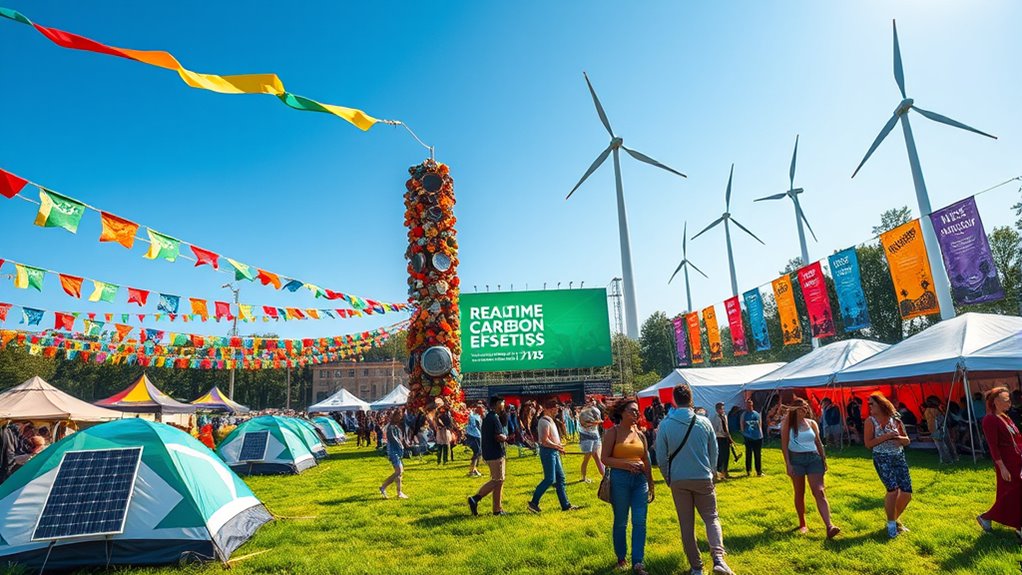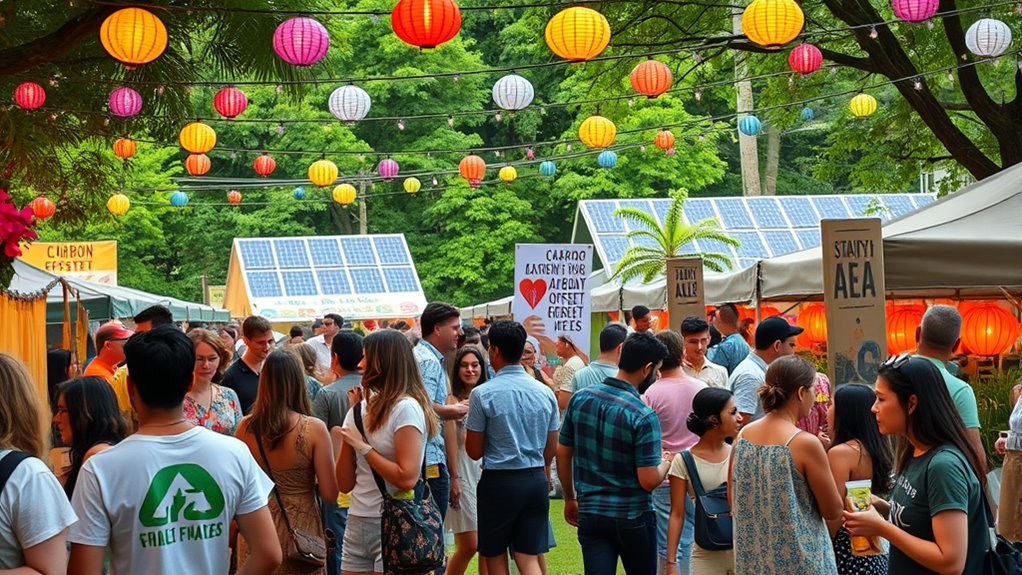Festivals are going green by using carbon offsetting initiatives to reduce their environmental impact. You might see event organizers investing in projects like forest preservation, renewable energy, or community programs to cancel out emissions from travel, electricity, and waste. Many also promote sustainable transportation options or generate on-site renewable energy. If you want to discover more about how these efforts work together to create eco-friendly festivals, there’s plenty more to explore.
Key Takeaways
- Festivals implement carbon offsetting programs to compensate for emissions from energy use, travel, and waste.
- Organizers partner with offset providers to fund projects like reforestation and renewable energy initiatives.
- Attendees are encouraged to purchase offsets, contributing to reduced net carbon emissions.
- Events integrate offsetting into their sustainability strategies, promoting environmental responsibility.
- Transparency about offset efforts helps raise awareness and demonstrates commitment to going green.

Many festivals are now turning to carbon offsetting to reduce their environmental impact, allowing organizers and attendees to enjoy celebrations without contributing as heavily to climate change. This shift is part of a broader effort to make events more sustainable, and one key approach involves promoting sustainable transportation. Instead of relying solely on personal vehicles or buses that burn fossil fuels, festivals are encouraging attendees to choose greener options like cycling, walking, or using public transit. Some organizers even provide shuttle services powered by renewable energy sources or incentivize carpooling to cut down on emissions. These measures not only reduce the carbon footprint but also ease traffic congestion and improve air quality around event sites.
In addition to sustainable transportation, festivals are increasingly adopting renewable energy sources to power their operations. Solar panels, wind turbines, and other clean energy technologies are now commonplace at many large-scale events. By installing solar arrays or partnering with local renewable energy providers, organizers can markedly lower their reliance on fossil fuels. Using renewable energy not only cuts greenhouse gas emissions but also sends a strong message to attendees that sustainability is a priority. It encourages attendees to think about how they can incorporate renewable energy practices into their daily lives. Moreover, some festivals even generate their own renewable power on-site, ensuring a more self-sufficient and eco-friendly event. Incorporating these practices often involves collaboration with local communities and green technology companies, promoting a broader sustainable development effort.
The integration of renewable energy adoption often extends beyond just powering the main event. For example, food vendors and merchandise stalls might run on solar-powered systems, while lighting and sound equipment are designed to be energy-efficient. These efforts demonstrate that sustainability can be woven into every aspect of a festival, from planning to execution. As an attendee, your role becomes even more impactful when you participate in these environmentally conscious practices. Opting for public transportation, bringing reusable goods, and supporting vendors who prioritize sustainability all contribute to the overall goal of reducing the event’s carbon footprint.
Frequently Asked Questions
How Do Festivals Calculate Their Carbon Footprint Accurately?
When you want to accurately calculate a festival’s carbon footprint, focus on festival logistics and emission measurement. You gather data on transportation, energy use, waste, and resource consumption. Then, you use standardized tools and protocols to measure emissions from these activities. By meticulously tracking these factors, you can estimate the total greenhouse gases emitted, helping you identify areas to reduce and offset emissions effectively.
What Types of Projects Do Festivals Fund for Offsets?
You’ll find that festivals fund various offset projects like renewable projects and forest conservation. Renewable projects include wind and solar energy initiatives that reduce reliance on fossil fuels. Forest conservation efforts help preserve existing forests, which act as carbon sinks. By supporting these projects, festivals actively work to balance their emissions and promote sustainable practices, showing their commitment to environmental responsibility and encouraging attendees to do the same.
Are Carbon Offsets Mandatory for All Festivals?
Imagine you’re planning a festival in the 21st century—carbon offsets aren’t mandatory everywhere, but many organizers seek them out. You might notice festival sponsorships and artist partnerships emphasizing green efforts, yet regulations vary by location. While some festivals voluntarily offset their emissions, others face mandates or industry standards encouraging it. Ultimately, your festival’s commitment to sustainability depends on your goals and the community’s expectations, not just legal requirements.
How Transparent Are Festivals About Their Offset Investments?
You might wonder how transparent festivals are about their offset investments. While some festivals clearly share details about their sponsorships and offset certification, others keep it less visible. It’s important to look for transparency reports or verified certifications, so you know their commitments are genuine. By choosing festivals that openly discuss their carbon offset efforts, you support genuine sustainability and hold organizers accountable for their environmental impact.
Can Festival Attendees Contribute to Carbon Offset Efforts?
As a festival attendee, you can definitely contribute to offset efforts. Your involvement matters, and many festivals encourage it through various offset contribution methods like donations, purchasing carbon offset tickets, or supporting eco-friendly initiatives. By actively participating, you help reduce the event’s overall carbon footprint. Your engagement not only supports sustainability but also promotes a greener festival culture, making your experience more meaningful and environmentally responsible.
Conclusion
As festivals foster fun and foster change, embracing eco-friendly efforts becomes essential. By boldly bridging the gap between gathering and going green, you can help harness harmony with the environment. Carbon offsetting creates a compelling, conscious community committed to conserving our planet. So, as you attend your next festival, remember your role in reducing footprints and fueling future festivities. Together, you can make meaningful, memorable moments while masterfully minimizing your environmental impact.









